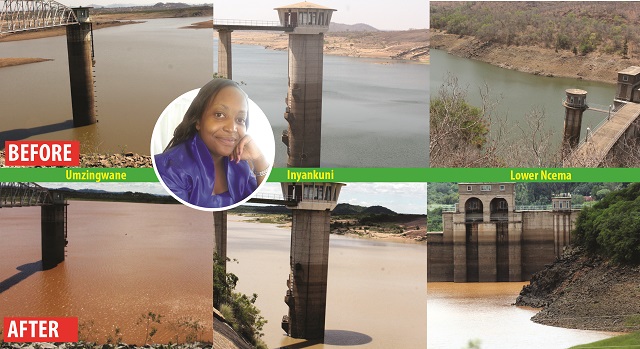
The Sunday News

 The collage shows Bulawayo city major supply dams before and after the recent rains. INSET: Bulawayo City Council public relations officer Miss Bongiwe Ngwenya
The collage shows Bulawayo city major supply dams before and after the recent rains. INSET: Bulawayo City Council public relations officer Miss Bongiwe NgwenyaVusumuzi Dube, Municipal Reporter
BULAWAYO residents have every reason to smile as the heavy rains that the country has been receiving have resulted in significant inflows to all the city’s supply dams, resulting in the council recommissioning one of the dams, Umzingwane.
Bulawayo City Council was, a couple of months ago, forced to introduce a 72-hour water shedding schedule as the local authority was trying to save water after water supplies had dwindled to a combined capacity of below 30 percent.
The water shedding was, however, lifted at the beginning of the year after it was discovered that the local authority was saving little or no water at all.
A tour of the city’s dams yesterday by a Sunday News crew revealed that all the six supply dams to the city have received inflows in the past couple of weeks with the local authority revealing that the dams are at 54 percent full. Statistics provided by the council’s public relations officer Miss Bongiwe Ngwenya revealed that just one dam- Upper Ncema- still remained decommissioned despite it being 50,24 percent full. The city’s largest supply dam, Insiza Mayfair has the highest quantity of water with Miss Ngwenya revealing that it was now 76,72 percent full.
“Mtshabezi Dam is 62,55 percent full, Umzingwane, 34,3 percent full, Lower Ncema 28,77 percent while Inyankuni is 21,36 percent,” she said.
In terms of inflows, Miss Ngwenya revealed that to date all the dams have received a total of 115 207 630 cubic metres with Insiza Mayfair getting the largest chunk of this figure at 57 243 480 cubic metres. Lower Ncema has received the least inflows at 2 372 530 cubic metres.
Council employees interviewed at some of the dams visited by this news crew revealed that they were confident that if the rains continue, some of the dams could spill.
“Our only problem right now is the illegal gold panners who are causing siltation in these dams. I believe we should have taken advantage of the period when our dams were largely empty to desilt them because due to the siltation the figures which we have could be highly misleading,” said a caretaker at Inyankuni.
Meanwhile, the Zimbabwe National Water Authority (Zinwa) revealed that by Thursday the country had seen a number of dams spilling. Responding to questions from Sunday News, Zinwa acting corporate communications and marketing manager Mr Tsungirirai Shoriwa revealed that the national dam level average has risen to 65,1 percent.
“Most of the country’s major dams continue to be on the rise as the country receives more and more rainfall. The intensified rainfall activity over the past two weeks has seen a number of the dams across the country filling up and spilling.
“The national dam level average has risen to 65,1 percent. Dams that are now spilling include Chivero, Ngwenya, Lower Mguza, Pollards, Khami, Harava, Bhiri-Manyame, Mundi-Mataga, Tuli-Makwe, Lower Mujeni, Manyuchi, Bangala, Chivake, Nyajena, Tokwane and Wenimbi. At least 230 million cubic metres of water are also held in the recently completed Tokwe Mukosi,” said Mr Shoriwa.
@vusadb



